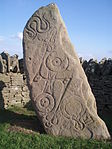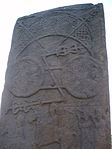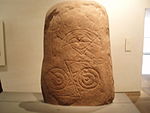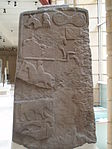Double disc (Pictish symbol)
- Double disc (Pictish symbol)
-
The double disc is a Pictish symbol of unknown meaning, that is frequently found on Class I and Class II Pictish stones,[1] as well as on Pictish metalwork.[2][3] The symbol can be found with and without an overlaid Z-rod (also of unknown meaning), and in combinations of both (as with the Monifieth 1 stone).
Gallery
|
|
|
Aberlemno 1; Class I stone with double disc and Z rod
|
|
|
|
Aberlemno 3 rear face detail; Class II
|
|
|
Monifieth 1; Class II stone with double discs with and without Z-rod
|
|
|
|
Detail of penannular ring on Whitecleuch Chain showing double disc and Z-rod
|
|
|
|
Plaque from Norrie's Law hoard showing Double disc and Z-rod
|
|
References
- ^ Fraser, Iain (2008), The Pictish Symbol Stones of Scotland, Edinburgh: Royal Commission on the Ancienct and Historic Monuments of Scotland
- ^ Graham-Campbell, James (1991), "Nome's Law, Fife: on the nature and dating of the silver hoard", Proceedings of the Society of Antiquaries of Scotland 121: 241–259, http://ads.ahds.ac.uk/catalogue/adsdata/PSAS_2002/pdf/vol_121/121_241_260.pdf, retrieved August 2, 2010
- ^ Clark, J Gilchrist (1880), "Notes on a Gold Lunette found at Auchentaggart, Dumfriesshire, and a Massive Silver Chain found at Whitecleugh, Lanarkshire, exhibited by His Grace The Duke of Buccleuch.", Proceedings of the Society of Antiquaries of Scotland 14: 222–224, http://ads.ahds.ac.uk/catalogue/adsdata/PSAS_2002/pdf/vol_014/14_222_229.pdf, retrieved August 1, 2010
Wikimedia Foundation.
2010.
Look at other dictionaries:
Pictish stones — are monumental stelae found in Scotland, mostly north of the Clyde Forth line. These stones are the most visible remaining evidence of the Picts and are thought to date from the 6th to 9th centuries.Purpose and meaningThe purpose and meaning of… … Wikipedia
Meigle Sculptured Stone Museum — View of the Meigle museum including the backs of Meigle 4 at left and Meigle 2 at right, with one side of Meigle 26 in the foreground.[1] The Meigle Sculptured Stone Museum is a permanent exhibition of 27 carved Pictish stones in the centre of… … Wikipedia
Monifieth Sculptured Stones — Monifieth 2, front face The Monifieth Sculptured Stones are a series of five class II and III standing Pictish stones from the early Medieval period found in or around St Regulus church in Monifieth, Angus, Scotland. Uncovered during the… … Wikipedia
Dunnichen Stone — Coordinates: 56°38′39″N 2°53′21″W / 56.6441°N 2.8891°W / 56.6441; 2.8891 … Wikipedia
Picts — This article is about the Celtic tribes. For the graphic file format, see PICT. The Aberlemno Serpent Stone, Class I Pictish stone, showing (top to bottom) the serpent, the double disc and Z rod and the mirror and comb … Wikipedia
Jarlshof — is the best known prehistoric archaeological site in Shetland, Scotland. It lies near the southern tip of the Shetland Mainland and has been described as one of the most remarkable archaeological sites ever excavated in the British Isles . [… … Wikipedia
Celtic art — is art associated with various people known as Celts; those who spoke the Celtic languages in Europe from pre history through to the modern period, as well as the art of ancient people whose language is unknown, but where cultural and stylistic… … Wikipedia
Rosemarkie Stone — The Rosemarkie Stone or Rosemarkie Cross is a Class II Pictish stone. It found at Rosemarkie, on the Black Isle of Easter Ross. On the front side is an elaborately decorated cross, while on the reverse side are various common Pictish symbols,… … Wikipedia
Rodney's Stone — is a two metre high Pictish cross slab now located close on the approach way to Brodie Castle, near Forres, Moray, Scotland. It was originally found nearby in the grounds of the old church of Dyke and Moy. It is classed as a Class II Pictish… … Wikipedia
Clach Biorach — A distance photograph of Clach Biorach taken in July 2006. The Clach Biorach (in English, Sharp Stone ) is a three metre Standing Stone located a 1/4 mile north west of the village of Edderton in Easter Ross. It dates to the Bronze Age, but two… … Wikipedia











